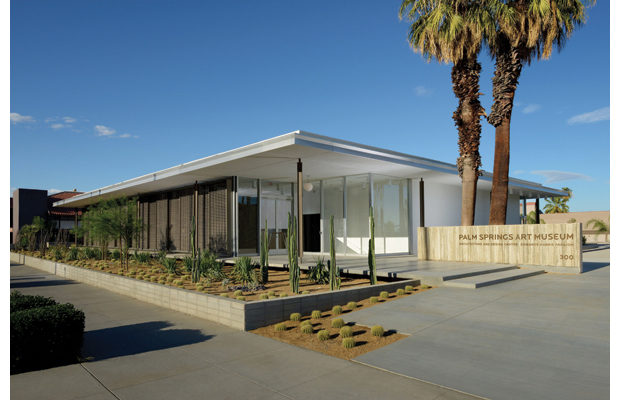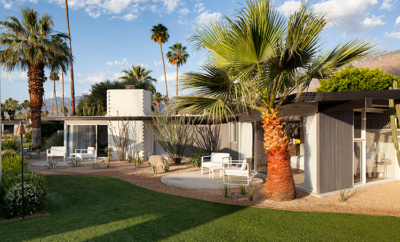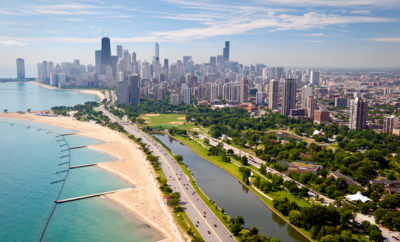
Architecture
Design Destination: Palm Springs
The Palm Springs Art Museum’s New Architecture and Design Center

The Santa Fe Federal Savings and Loan branch in Palm Springs, California, was designed by E. Stewart Williams. It has recently been renovated and opened as the Architecture and Design Center (A+D Center) of the Palm Springs Art Museum.
WHAT FLORENCE IS TO RENAISSANCE architecture, Palm Springs is to mid-century modern. It boasts the world’s highest concentration of the ever-hip postwar buildings and now has an innovative museum facility specializing in their study and display. Housed in a repurposed mid-century bank building, the Palm Springs Art Museum’s new Architecture and Design Center (A+D Center) offers the sort of harmony between art and exhibition space unseen since the opening a quarter century ago of Bruce Goff’s Pavilion for Japanese Art at the Los Angeles County Museum of Art.
The A+D Center is located in the Edward Harris Pavilion, a thirteen thousand-square-foot, former Santa Fe Federal Savings and Loan branch designed by E. Stewart Williams in 1960. With its cruciform columns, glass walls, and elevated setting on a plinth, the building tips its hat to Ludwig Mies van der Rohe’s Barcelona Pavilion of 1929.

Williams outside the bank building in a 1962 photograph by Julius Shulman.
Williams had designed the Palm Springs Art Museum’s first purpose-built venue—a ten thousand-square-foot building—in 1958 and would, in 1974, be commissioned to design the 150,000-square-foot flagship building. Given this shared history it comes as no surprise that the A+D Center dedicated its first exhibition to him. Titled An Eloquent Modernist: E. Stewart Williams, Architect, the show provided a satisfying overview of the career of this gifted and prolific architect and a key to mid-century modern architecture in Palm Springs.
In 1947, a decade after earning degrees from Cornell and the University of Pennsylvania, Williams joined his father and brother in the thriving firm of Harry J. Williams. “Stew” Williams’s first, serendipitous, commission was a residence for Frank Sinatra—who walked into the Williams office intending to commission a Georgian colonial redolent of Beverly Hills, but quickly agreed to the mid-century modern design that he would live in for decades. (It is unclear what Williams thought of Sinatra’s piano-shaped pool.)
Williams became a central figure in the growth of the desert city one hundred miles east of Los Angeles. In addition to the original museum (and later additions), he designed numerous banks and hospitals, dozens of residences and schools, Palm Springs’ City Hall, Temple Isaiah, Crafton Hills College, and the mountaintop station of the Aerial Tramway. He was one of a small group of architects—John Porter Clark, William F. Cody, Albert Frey, John Lautner, Richard Neutra, and Donald Wexler among them—who helped transform Palm Springs from a provincial village into a hub of mid-century architecture. There were various reasons for this achievement: the invention of air conditioning and the postwar demand for housing, the continuing interest of Hollywood in well-publicized weekend getaways, and the glamorizing photographs of Southern California architecture taken by Julius Shulman. But it was its suitability to the desert climate and lifestyle that ensured the success of mid-century modern architecture there. Its integration of indoors and outdoors derived from Frank Lloyd Wright and its straightforward Bauhaus-derived building techniques and use of sustainable materials help explain its continuing influence.

Williams’s 1954 house for Marjorie and William Edris is now the residence of architect J. R. Roberts, the A+D Center’s managing director, who restored it with Williams’s input.
In addition to what was built, the exhibition provided fascinating glimpses of what might have been. The museum, for instance, was originally intended to have an additional story, as shown in one of the drawings on view. But the zoning variance that would have transformed its sprawling horizontality into a more welcoming, centralized composition was denied.
Ties between Williams, who died in 2005, and the Palm Springs Art Museum transcend the architectural realm: his daughter-in-law Sidney Williams is the museum’s longtime curator of architecture and one of the initial proponents of the A+D Center; architect J. R. Roberts, the A+D Center’s managing director, owns Stew Williams’s iconic Edris house (1954) and restored it with input from him—including the elimination of a crumbling exterior wall that had enclosed an area for “nude sunbathing,” as originally specified by the Edris family and seen in a deftly drawn plan that hung in the show. Roberts hired architect John Boccardo to assist with the restoration of the house. With Marmol Radziner, Roberts would go on to direct the bank’s meticulous renovation and transformation into the museum.
Interestingly, in separate conversations about the creation of the A+D Center both Roberts and Sidney Williams cited the landmarking of the former bank as the most essential step in the process. (Williams is the former chair of the Palm Springs Historic Site Preservation Board and sat on the board of Modernism Week, while Roberts is a city planning commissioner and vice president of PS ModCom, a preservation group.) The initial task, Williams explains, was “getting Class 1 historical designation for the bank in 2009. [Developer] John Wessman owned the building and was going to wrap four-story condos around it, destroying views of it from two sides. We had to get him on board… and he ultimately became an enthusiastic supporter of the project.” (Wessman’s controversial role in the revitalization of Palm Springs’ downtown resembles that of developer Larry Silverstein’s in the halting rebuilding of the World Trade Center.)
The bottom line, Roberts notes, is that the renovation “succeeds in solving the problem of showing prints and drawings in a building with glass walls.” Upcoming exhibitions will test these limits by featuring three-dimensional, sometimes hybrid, objects in keeping with the A+D Center’s expansive vision of architecture and design in an era when the boundaries separating disciplines are melting away. They include a show called Killer Heels, about high-heel shoe design, and Eye on Design: Andrea Zittel’s Aggregated Stacks, organized by the museum’s chief curator Daniell Cornell and devoted to the conceptual art/design of an artist who fashions shelves and storage from throwaway packing boxes, augmented by design objects from the museum collection.

Founded in 1938 as the Palm Springs Desert Museum, the museum initially specialized in Native American artifacts and the natural sciences of the Coachella Valley and began to exhibit art only in 1958. Seventeen years later, it changed its name to the Palm Springs Art Museum and in 2013, it celebrated its seventy- fifth anniversary.
The center’s opening also marks the culmination of a period of expansion for the museum unprecedented since the 1970s. During the leadership of Steven Nash, the former JoAnn McGrath Executive Director, attendance at the Palm Spring Art Museum rose 70 percent and endowments by 30 percent; the permanent collections increased by 25 percent, and two new campuses were added—The Galen and the Faye Sarkowsky Sculpture Garden in Palm Dessert and the Architecture and Design Center in Palm Springs.
Nash officially retired on January 1, and has been succeeded by Elizabeth Armstrong, a well-regarded curator who’s worked at major institutions in Minneapolis and Southern California.) Discussing his tenure at the museum, Nash notes the difficulty of singling out his most satisfying accomplishment there. When pressed he says, “I would have to say that I’m proudest of the overall, institution-wide leap in quality. That is, the big picture, the museum’s emergence—if you allow me a little bragging—as one of the best middle- size museums in the country.”
More than a little bragging seems entirely in order, Dr. Nash.











